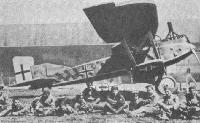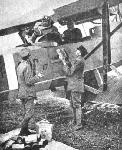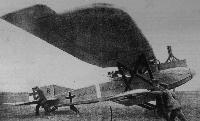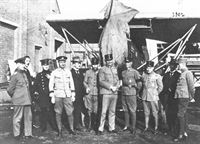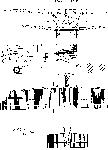В.Кондратьев Самолеты первой мировой войны
ЮНКЕРС J-l (J 4) / JUNKERS J-l (J 4)
Цельнометаллический свободнонесущий полутораплан. Передняя часть фюзеляжа, включая кабину, представляла собой бронекоробку, склепанную из 5-6-миллиметровых стальных листов. Каркас задней части фюзеляжа и крыльев составляли ферменные конструкции из дюралевых труб. Обшивка крыльев и оперения - гофрированный дюраль, а задней части фюзеляжа - полотно.
Самолет с заводским индексом J 4 и военным обозначением J-1 - первая серийная машина знаменитого авиаконструктора Хуго Юнкерса. Разработка проекта начата в середине 1916 года по заказу военного командования на тяжелый, бронированный аэроплан для непосредственной поддержки наземных войск.
Первый полет прототипа состоялся в январе 1917-го, а в мае серийные машины начали поступать на западный фронт. Всего до конца войны на фирмах Юнкерс и Фоккер построено 189 экземпляров J 4 и еще 38 сдано по окончании военных действий.
Несмотря на плохую скороподъемность и слабую маневренность, обусловленные недостаточной мощностью двигателя, самолет заслужил самых высоких оценок у летчиков и у пехоты. Благодаря бронированию и очень прочной конструкции из негорючих материалов, он считался практически неуязвимым от огня стрелкового оружия.
"Юнкерсы" бомбили и обстреливали из пулеметов окопы неприятеля, а также осуществляли снабжение по воздуху немецких солдат на передовых позициях, куда из-за обстрелов не могли прорваться грузовики и повозки с боеприпасами и провиантом. При этом известно всего несколько случаев гибели "Юнкерсов" от зенитного огня или атак истребителей. J 4 считался самым "несбиваемым" самолетом Первой мировой войны.
Широкую известность получил эпизод, когда одна из машин благополучно вернулась на аэродром с 480 пробоинами от пуль и осколков! Даже в случаях аварийных посадок бронекорпус надежно защищал экипаж от травм и увечий.
Единственным серьезным недостатком J 4 была чрезмерно длинная по тем временам взлетно-посадочная дистанция, не позволявшая эксплуатировать самолет на большинстве прифронтовых аэродромов.
ДВИГАТЕЛЬ
"Бенц" Bz.IV, 200 л.с.
ВООРУЖЕНИЕ
1 турельный "Парабеллум". На некоторые машины дополнительно устанавливали перед кабиной два пулемета, стрелявшие вперед-вниз через отверстия в бронекорпусе.
ЛЕТНО-ТЕХНИЧЕСКИЕ ХАРАКТЕРИСТИКИ
Размах, м 16,0
Длина, м 9,1
Площадь крыла, кв.м 49,4
Сухой вес, кг 1766
Взлетный вес, кг 2176
Скорость максимальная, км/ч 155
Время набора высоты, м/мин 2000/32
Показать полностью
A.Kay Junkers Aircraft and Engines 1913-1945 (Putnam)
Junkers J4 (J.I)
The Flugzeugmeisterei, although impressed by the revolutionary metal construction of Junkers’ aircraft, did not see them as fighters but rather as ground-attack aircraft having the most useful ability to withstand small-arms fire. Junkers were therefore asked to develop an armoured ground-attack biplane, and this was designated J4 by the company and JI by the military (thus forever causing confusion with the original Junkers J1). The design and development of the J4 was the responsibility of Reuter, Steudel, Brandenburg and also Professor Dr G. Madelung, who was later (1934) to work out designs of flying bombs and aircraft to utilise Paul Schmidt’s pulsejets.
The J4 was a two-seat sesquiplane (a biplane with the bottom wings of shorter span than the top wings), its bottom wing attached to the base of the fuselage and the top wing supported on struts at the centre section only. Based on work on the J3, a tubular structure was used with corrugated Duralumin covering for the wings and tail surfaces, although early models had fabric-covered elevators. Ailerons were fitted to the top wings only; once the aircraft was in production, these ailerons were lengthened to project beyond the wing tips and the wing span was increased. The engine and the crew of two were enclosed in an armoured chrome-nickel steel tunnel to protect them from ground fire, and the rest of the fuselage was covered in smooth Duralumin sheet (although there was fabric covering on the rear section on early models).
Power was supplied by a 200hp Benz Bz IV six-cylinder in-line engine, and the armament consisted of two fixed, forward-firing 7.92mm LMG 08/15 machine guns plus one 7.92mm Parabellum machine gun on a trainable mounting for the rear-cockpit observer. Later a Mercedes D IVa engine of 256hp was tried, but this was not fitted in production aircraft.
Three prototypes were built at Dessau, and the first (c/n 425/17) made its maiden flight on 28 January 1917. By August that year, following many delays and setbacks suffered on the production line, the first batch of fifty J4s (c/ns 100/17 to 149/17) had begun entering service at the Front. They proved to be successful and popular with their crews owing to their survivability, one machine sustaining more than 400 small-arms hits without failing. By the end of the First World War in November 1918, another 177 aircraft had been delivered for service, giving a total production by the war’s end of 227.
Data: Span 16.0m (52ft 6in); length 9.1m (29ft 10 1/4in); height 3.4m (11ft 1 3/4in); wing area 49.4m2 (533 sq ft); empty weight 1,766kg (3,892lb); loaded weight 2,176kg (4,798lb); max. speed 155kph (96mph); endurance 2hr.
Показать полностью
O.Thetford, P.Gray German Aircraft of the First World War (Putnam)
Junkers J I
To succeed and supplement the interim A.E.G. and Albatros J types (which had been little more than modified C types) the Junkers J I arrived in the Infanterieflieger units in 1917. It should be noted that the factory designation of this machine was J 4. In the past this has often been confused with the military J I designation.
The J I was mainly the product of Dr. Hugo Junkers' fertile brain. Dr. Junkers had pioneered the construction of all-metal monoplanes in 1915, when he produced the 120 h.p. Mercedes-powered cantilever J 1. This was followed in 1916 with an extremely neat and modern-looking monoplane, designated J 2, of which several were built. These aircraft were technically superior in constructional technique to anything that was then flying, though somewhat under-powered. Notwithstanding, the German authorities were so impressed with his constructional methods that Junkers was asked by the Flugzeugmeisterei to produce an armoured biplane. The first machine was partly designed by Prof. Madelung, who originally wanted it to be a parasol. It was completed early in 1917 and was of unique format. Corrugated sheet covering was used, as opposed to the plain sheet metal of the earlier J 1 and J 2. The medium was no longer tinplate (Eisenblech - literally sheet iron), but an alloy riveted to a dural frame. This aircraft became the J I, and it may be noted that Anthony Fokker was in no way connected with the enterprise at this time; his association with Junkers was not until October 1917.
The unorthodox layout of the Junkers J I was comprised of a large upper and a small lower cantilever wing combined with a hexagonal-shaped fuselage, bestowing an angular yet curiously racy appearance. A completely armoured nose capsule of 5 mm. chrome-nickel sheet steel enclosed the engine and crew compartment, terminating in a solid bulkhead to give protection from immediately astern. To this was joined the rear half of the fuselage, consisting of an alloy tube frame which was fabric covered, although some of the last production machines had the corrugated skin. The tailplane and split elevators were of near rectangular shape. On the prototype a plain triangular fin and near rectangular-shaped, unbalanced rudder vas fitted, the fin being braced to the upper longerons by steel struts on either side. On production machines the fin was cut down in height and braced alternatively by a vee strut or a single strut on either side, and a horn balance portion was incorporated in the rudder, which was otherwise of parallelogram shape. Again the empennage was a dural-tube frame with corrugated covering.
Of vast proportions, the upper wing was in three roughly equal panels, the centre-section being of constant chord with a large semicircular cut-out. The outer panels had some 5" of sweep on the leading-edge only, and were rounded to graceful rake at the tips. Ailerons of constant chord extended the whole length of the outer panels, and on the prototype were unbalanced. On the production machines, however, a large overhung balance portion was added; the chord was also increased, which gave the trailing edge a cranked appearance. The lower wing was of the same profile but only about one-third the area of the upper wing. Construction of the wings was based on a series of tubular dural spars, as many as eleven at the full chord of the upper wing - five top surface, six bottom surface. To these were riveted tubular diagonals which spaced the spar tubes according to the depth of the required aerofoil section and, in effect, formed a Warren girder-type rib skeleton. When the corrugated 2 mm. dural skin was riveted to this basic framework it completed the triangulation of the rib structure and automatically assumed the desired aerofoil section. The upper wing was supported by four struts on each side, two springing from the bottom longerons and the other two from the lower wing, which was attached to a keel section underneath the fuselage. The lower wing was additionally braced to the bottom longerons by three short centre-section struts; this manner of a ring the wings gave the fuselage a slung appearance, as in the Bristol Fighter.
The undercarriage chassis consisted of three struts on each side, two springing from the centre of the lower wing and the third rising vertically from the apex of the other two to join the leading edge. The axle was sprung by being bound to the chassis with elastic shock cord. The only wooden part of the aircraft was the sturdy ash tailskid, which was hinged on an inverted pylon and internally sprung.
The Benz engine of some 200 h.p. was fitted with high-compression cylinders and was completely enclosed in the armoured capsule, with additional panels encowling the actual cylinder block. These upper panels of armour were hinged at their rear end and swung outwards to allow easy access to the engine for servicing A long narrow radiator was fixed under the centre-section directly in the slipstream. On the earlier production models a vertical-type exhaust manifold curved back towards the top wing, but this was later replaced by a straightforward upright manifold. Most J Is were equipped with a large spinner which certainly helped to soften the angularity of the general lines, but these were frequently removed in the field.
All flight controls were positively operated by direct linkage through a system of cranks and control push-rods, all enclosed within the airframe, and nowhere in the control system were cables used at all. This made for much greater invulnerability to small-arms fire from the ground, to which the J Is were continually subjected.
The Junkers J I began to equip the Ft. Abt. (Inf.) units towards the end of 1917. Once crews had adapted themselves to this revolutionary aeroplane they viewed it with considerable favour, welcoming the measure of protection its armour afforded. Although heavy, cumbersome and difficult to land and take-off from rough ground, the J Is were immensely strong and well suited to their contact patrol duties, which consisted primarily of establishing the course of the Front Line and its alterations. All work was done at low altitude, and usually the observer reported the position to the rear command post by radio, although quite often message bags were dropped. Certainly these reports were the most reliable sources of news to the commanders in battle. Infantry co-operated with the aircraft by laying out cloth-strip ground signals or burning smoke flares to indicate their position. Ammunition and rations were dropped to machine-gun nests, trench systems and outposts that had been cut off and could not otherwise be supplied.
Armament of the J Is was conventional, comprising two synchronized Spandaus firing forward and a Parabellum machine-gun manually operated by the observer. The mounting of twin fixed downward-firing machineguns had been found unsatisfactory due to the impracticability of aiming at ground targets from a low height, owing to the aircraft's speed.
A total of 227 Junkers J Is was built.
TECHNICAL DATA
Description: Close support, armoured two-seater.
Manufacturer: Junkers Flugzeug-Werke A.G. Dessau. (Junk.).
Power Plant: One 200 h.p. Benz Bz IV 6 cylinder in-line water-cooled engine fitted high-compression cylinders.
Dimensions: Span, 160 m. (52 ft. 6 in.). Length, 91 m. (29 ft. 10 3/8 in.). Height, 3.4 m. (11 ft. 1 5/8 in.). Area, 49.4 sq.m. (533.52 sq.ft.).
Weights: Empty, 1,766 kg. (3,885 lb.). Loaded, 2,176 kg. (4,787.2 lb.).
Performance: Maximum speed, 155 km.hr. (96.875 m.p.h.). Climb, 2,000 m. (6,560 ft.) in 32 min. Endurance, ca. 2 hr.
Armament: Two fixed Spandau machine-guns forward and one manually operated Parabellum machine-gun in rear cockpit.
Показать полностью
J.Herris Development of German Warplanes in WWI (A Centennial Perspective on Great War Airplanes 1)
J-Class Armored Aircraft
Still another role for which specialized aircraft were needed was infantry cooperation. In those days before easily-portable voice radios, there was no good way for headquarters to keep in contact with the moving front line of infantry during an attack. To solve this problem, two-seat aircraft were flown at low level to observe the moving front of the infantry attack and keep headquarters informed of its progress so the attack could be properly supported with reinforcements, re-supply, and adjusting the advance to enemy actions. Standard C-type aircraft were vulnerable to small-arms fire at the low altitudes they had to fly to succeed in this mission and losses started to become unacceptable. The obvious solution was a two-seat airplane armored against small-arms fire, and this new Idflieg requirement created the J-Class. The letter 'I' was not used to avoid confusion with the numeral '1', so the new class of armored two-seaters was called the 'J' class, 'J' following 'I' in the alphabet. The J-type was introduced to combat in the summer of 1917 and the excellent results the type achieved lead to substantial orders and a steady increase in the numbers at the front despite combat attrition. According to Hoff, a total of 238 J-types were listed in the Frontbestand for October 1918.
Three manufacturers designed aircraft to the J-type requirement, and all three were placed in production. Most successful and most technically significant was the Junkers J.I, the first all-metal production airplane in the world. Corrugated metal was used for the skin for sufficient stiffness, and the engine and crew members were surrounded by an armored 'tub' that protected them from ground fire. The Junkers J.I became an immediate success and was in production and use until the end of the war. It had two main limitations; first, its innovative metal structure was time-consuming to build, limiting production. Second, it was very heavy, which limited the size of airfields it could use and earned it the nickname 'furniture van' from its crews. The Junkers J.I was known to survive 200mm shell holes in its wings, and none are confirmed to have been shot down by enemy fighters.
Показать полностью
M.Dusing German Aviation Industry in WWI. Volume 1 (A Centennial Perspective on Great War Airplanes 84)
Junkers-Fokker-Werke, AG, Dessau (Junk and Jfa)
Foundation:
<...>
In the fall of 1917, Junkers merged with Fokker on government orders to increase the production of its factories.
The “Junkers-Fokker-Flugzeugwerke” A. G., which was founded in this way, had new buildings constructed in Dessau. The new company set forth especially the construction of the metal airplanes.
During the war, the Flugzeugmeisterei gave the “Junkers” factories the short name “Junk”, after the merger with Fokker: “Jfa”. Fokker near Schwerin had the abbreviation “Jfo”.
Aircraft Development:
<...>
During this period (late 1916) Junkers received a trial order to build 3 experimental J-airplanes (armored biplanes for ground combat) with 200 hp Benz engines. Although the J4 (military J.I) aircraft, which underwent its flight tests at Doberitz in February 1917, had a mass of 2,000 kg, which was enormous by the standards of the time, it proved that the required climb times could also be achieved in metal construction. The first armored aircraft for the front were released in the summer of 1917 and had quite satisfactory results, so that series production could begin. Duralumin instead of steel was used for the first time in the J4/J.I. Due to the lower strength, reinforcing corrugated sheets made of duralumin were also used for the first time in the structural area of the J4. Incidentally, there was also a single J4 in which the entire fuselage, including paneling, was built from duralumin for test purposes.
<...>
All in all, it can be said that the two partners, Fokker and Junkers, pursued too different approaches to aircraft construction, so that a fruitful collaboration did not materialize after the takeover. It was not until after the end of the First World War, when both entrepreneurs went their separate ways again, that decisive impetus was given to aircraft construction by both companies.
Story behind the fusion from Fokker and Junkers (taken from “The Hugo Junkers Homepage" by Horst Zoeller
The initial Junkers aircraft J1 to J3 and the J4 prototypes were still produced within the Junkers & Co. workshops. Following the successful tests of the Junkers J4, Idflieg was interested in a serial production of this combat aircraft. However, Idflieg was not convinced with the Junkers facilities in Dessau, as Junkers did not have any experience in a large-scale serial production of aircraft. Nevertheless, an initial order for 50 Junkers J.4s was placed in February 1917. Difficulties with the material supply of the armour plates, which were provided by Huttenwerk Dillingen and change requests from the still ongoing test program at Adlershof resulted in the Idflieg expected delivery delays. The first aircraft 100/17 was delivered in August 1917 for front tests. At this time Junkers was still unable to put out the promised number of 30-50 aircraft per month. Therefore, Idflieg refused to put any further orders for the J4 until Junkers solved his production problems. Idflieg also promoted a merger with one of the larger experienced aircraft manufacturers in Germany. Due to the missing Idflieg orders Junkers got into financial problems and therefore started discussions with several potential partners, like Daimler, Stinnes, Siemens-Schuckert, Bosch, Aviatik, Oesterreichsiche Fiat, and Fokker as well.
The experienced manufacturers were interested in picking up the J4 design for their own production lines and offered Junkers a minority shareholder position. But Hugo Junkers still intended to set up an own production line at his facilities at Dessau and was therefore looking for a partnership with knowledge transfer. Camillo Castiglioni of the Oesterreichische Fiat made a promising offer leaving Hugo Junkers with 70 percent of the shares. The joint venture company was intended to take a license agreement for the J4 from the Forschungsanstalt at Dessau and Fiat would be responsible for the setup of a serial production in the new company. However, these discussions did not come to a successful end.
Anthony Fokker was another discussion partner. Instead of picking up the J4 for his own production lines, he offered the setup of a new facility at Dessau. As the Fiat offer, the Fokker offer was heading for a license agreement between the new company and the Forschungsanstalt. Junkers and Fokker should hold 50 percent of the company. On 20th October 1917 the Junkers-Fokker-Werke A.G. was founded at Dessau with a capital of 2.6 Mio. Mark. The Junkers capital was added with facility grounds, tools and materials.
Following the foundation of the Junkers-Fokker-Werke Idflieg promptly put several orders for Junkers aircraft. With the engagement of Fokker at the Junkers facility and with additional staff from the Fokker-Werke at Schwerin the production rate at Dessau was raised from 17 J4 aircraft in January 1918 to 31 aircraft in October 1918. However, this was still less than the promised output rate of 50 aircraft per month. Initially the J.4s were shipped to Doberitz for flight tests, still in 1917 the flight tests were transferred to Wurzen near Leipzig. In May 1918 Junkers was able to offer test flights at a newly established airfield at Dessau as well. At least with the production setup of the Junkers J.9 new complexities arise.
To increase the number of available J4 aircraft, in Summer 1918 Idflieg placed orders at other aircraft manufacturers for the J4 as well. In June 1918 a number of 100 J4 aircraft were ordered at Linke-Hofmann in Breslau. But as the license discussions between Linke-Hofmann and the Junkers did not make progress, this order was later cancelled. Another third-party order was put by Idflieg at Hansa-Brandenburg for a total of 50 Junkers J9 aircraft. Again, this third-party order was not realized. Therefore, all WWI Junkers aircraft were produced at Junkers & Co. or at Junkers-Fokker-Werke. At the end of WWI deep differences between Junkers and Fokker existed. During the time of Junkers-Fokker-Werke Fokker always tried to transfer technological knowhow from the Junkers-Fokker-Werke to his own facilities at Schwerin. Additionally, Fokker took opposite positions to Junkers’ designs as he liked to promote his own aircraft at Idflieg. On the other hand, Jco and Jfa were competitors regarding Idflieg orders, at least a number of pre series aircraft were built at Jco. Therefore, when WWI came to an end, both Hugo Junkers and Anthony Fokker quickly separated from each other, and the Junkers-Fokker-Werke were dissolved.
Показать полностью
P.Grosz, G.Haddow, P.Shiemer Austro-Hungarian Army Aircraft of World War One (Flying Machines)
Junkers J.I
The all-metal Junkers J.I ground attack biplane, with its armored engine and crew compartment, had proved a useful weapon on the Western Front for performing ground contact patrols. Strafing attacks by Brandenburg C.I biplanes on Italian positions had demonstrated the effectiveness of such tactics, but the LFT was eager to reduce aircrew casualties. In July 1918, the purchase of two Junkers J.I biplanes was approved and two 250 hp Benz(Mar) engines were dispatched to Dessau for installation. Generalmajor Uzelac and members of his technical staff visited Junkers-Fokker on 28 September 1918 to inspect the factory and airfield. Since no aircraft had been delivered when the war ended, the contract was annulled.
Показать полностью
Журнал Flight
Flight, November 28, 1918.
THE JUNKER ARMOURED BIPLANE
FOR some time past there have been rumours current of a German all-metal aeroplane in which, it was said, even the wing covering was of metal. It is not, however, until quite recently that we have been able to obtain reliable information concerning this machine. What is left of the Junker biplane, as the machine in question is called, is now included among the many interesting exhibits at the Enemy Aircraft View Rooms at the Agricultural Hall, Islington, where our representatives have been permitted to examine this machine in detail.
Owing to the damaged condition of the specimen on view it has not been possible to give, this week, more than a brief outline of the main characteristics of the machine. Later we hope to be able to describe it in more detail.
The Junker armoured biplane is designed for use as a trench fighter, and in contradistinction to the A.E.G. armoured biplane it was evidently designed with this object in view from the start, the armour not being attached, as a supplement, to an ordinary girder structure, as was the case with the A.E.G., but forming the main fuselage structure at the same time as providing the armouring.
The shape of the front portion of the fuselage may be seen in one of the accompanying photographs. It has flat sides of armour plating, and a slightly curved top of aluminium. The bottom of the body is formed of three fiat surfaces, the middle one of which is horizontal, the other two sloping so as to connect the edges of the horizontal bottom with those of the vertical sides. The engine, a 230 h.p. Benz, is also protected by armour plating, which is detachable so as to allow access to the engine. This is accomplished by hinging the armour at this point, the port and starboard engine armour being separately detachable. In the accompanying photograph the engine armour of one side will be seen lying on the floor in front of the fuselage. The armouring is finished off just behind the gunner's cockpit, where it is continued across the fuselage by a curved armour plate shaped to form the gunner's back rest.
Of the rear portion of the fuselage nothing remains on the machine examined, and nothing can therefore be said regarding the details of its construction. Judging from such evidence as fittings for large diameter tubes at the four corners it would appear that the rear part of the fuselage has been built up of a tubular framework of Duralumin.
The wings of the Junker are of great interest as being of a construction very dissimilar to any so far seen. The internal construction of the wings is in the form of Duralumin, tubes crossing diagonally and connecting the tubular spars, which latter are far greater in number than is ordinarily found in an aeroplane wing. It has evidently been the aim of the designer to distribute the spars over the wing section rather than to provide two spars located in the usual manner. In the Junker there may be said to be six spars if one counts the top and bottom tubes lying vertically above one another as one spar. The lower photograph will give some idea of the general distribution of the various wing members.
In section the planes of the Junker are enormously deep, the maximum thickness of the top plane being about 16 in. The chord of this wing is a little over 8 ft. while the chord of the bottom plane is approximately 5 ft.
From the fact that no trace was found of inter-plane strut fittings it would appear that these members have been dispensed with in the Junker. It appears that the top plane centre-section was carried on a structure of tubes from the body, while the bottom plane appears to have been attached to the bottom of the fuselage by a series of diagonal struts. This arrangement, which would be made possible by employing such a deep wing section, would have the advantage that the gunner could fire forward at a considerable angle without danger of hitting a vital member of the wings.
The undercarriage is in the form of two Vees, attached to the lower plane some distance out. From this point the bracing tubes of the bottom plane run to the body, thus transmitting the shock to the fuselage without, presumably, causing excessive bending stresses in the lower wing spars.
The wing covering is in the form of corrugated aluminium sheet, and it was noticed that this did not form a fair curve over the wing framework, but was rather in the nature of a series of straight lines. This could hardly improve the aerodynamic qualities of the wing section, but on the other hand it is possible that the effects are not great. Later we hope to be able to give some details of this interesting machine.
Показать полностью













